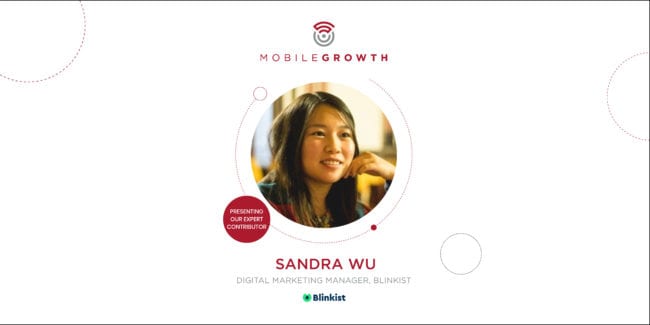By SANDRA WU
Most apps rely solely on Facebook for acquisition. It has the most mature targeting options of any advertiser out there, and also delivers on scale. However, if you want your app to stand out from the crowd, you have to try other means.
At Blinkist, we’ve found success with paid content marketing, an advertising strategy that drives people to a blog rather than the app store. This might seem like a long-winded way to sell a product, but if you do it right, it can be very profitable.
The magic of content marketing actually lies in the extended funnel. People are a lot more likely to click on an article than an ad – and once they’ve read 800 words about your product, they’re more willing to try it out, stay engaged, and spread the word.
Here’s what paid content marketing means for your bottom line:
| What you will see | What the numbers will show |
| People are more likely to click on an article than an ad | 2x the CTR, which leads to 50% lower CPCs |
| Once they’ve read 800 words about your product,
they’re more willing to: |
|
| …try it out | 30% higher purchase rates |
| …stay engaged | 11% higher LTV |
| …spread the word | uplift on organic traffic |
Source: Blinkist
Not only will the numbers look better, the brand impact is tremendous. Unlike the typical ad on Facebook and Instagram, an article gets a lot more shares, giving additional exposure to your app.
Getting Started with Paid Content Marketing
Get the content right. It isn’t easy to sell a product through an article, but it’s not rocket science. You just have to write something that people want to read about, which also has a strong connection to your product. If you can nail those two things, you’ve got yourself a fantastic value proposition.
A lot of advertisers resort to clickbait articles such as “5 Reasons Why People Are Downloading This App, You Won’t Believe #3!”. This might work when you pay on a CPM basis, but with content distribution, you’ll likely pay per click. You don’t want everyone to be interested in your article, just the right people.
Set expectations from the start. In general, you should set the right expectations, so conversion rates stay up and you get your money’s worth. To put that in perspective, let’s pretend that we’re selling a hiking app. Which article would you advertise?
Title 1: 5 Tips On How To Have A Relaxing Holiday In The Alps
Title 2: This Hiking App Is What You Need For A Holiday In The Alps
You might be inclined to choose the first one because more people would be interested in it. However, the people who do pick that article wouldn’t expect to read about an app, so they’ll be a lot less likely to convert, and even less likely to make any in-app payments. In the end, you’re better off promoting the second title.
Before you start writing an article, ask yourself if it would solicit the right people. If not, keep brainstorming.
Find the right place to advertise your content. Around a decade ago, native advertising companies Outbrain and Taboola realized that news publishers were struggling to monetize their content, and offered them an option to sell their inventories to other publishers. This led to the birth of the “From around the web” section at the end of nearly every article you read. As you can imagine, that can amount to significant exposure for many content marketers. While Facebook and Instagram give you those active on social media, native advertisers can give you everyone who reads news online.
Outbrain and Taboola are the most popular networks, and, in my opinion, there’s no need to consider other networks until you’ve succeeded with one of these. To pick which one to start with, check out their portfolio of publishers and see which one has a better match with your product.
If you’re short on resources, another option is to test your content on Facebook as sponsored posts. You can validate ideas rather quickly without the pressure of launching a new channel. However, be mindful that the potential is much smaller there, as you’re just getting a slightly bigger piece of the same pie.
Be patient and play the game. Unfortunately, despite following the advice above, you still might not see returns, but that’s a part of the game. When the numbers are not to your liking, it’s important to figure out what the bottleneck is by looking at your CTR, signup and purchase rate, and iterate accordingly. It could take months before you get all your ducks in a row, but when it does, it’s going to be the gift that keeps on giving.
At the end of the day, it might be tempting to stick to more established channels. It can take a lot of effort to set up paid content marketing, and there are no guarantees that it will pay off. However, if you want to make your app a household name, you need to start considering alternative means that will have a long-lasting impact on your brand.
Sandra Wu is Content Marketing Specialist at Blinkist, passionate about mobile apps, eCommerce and developing markets. Can cut onions without crying.





 0
0



